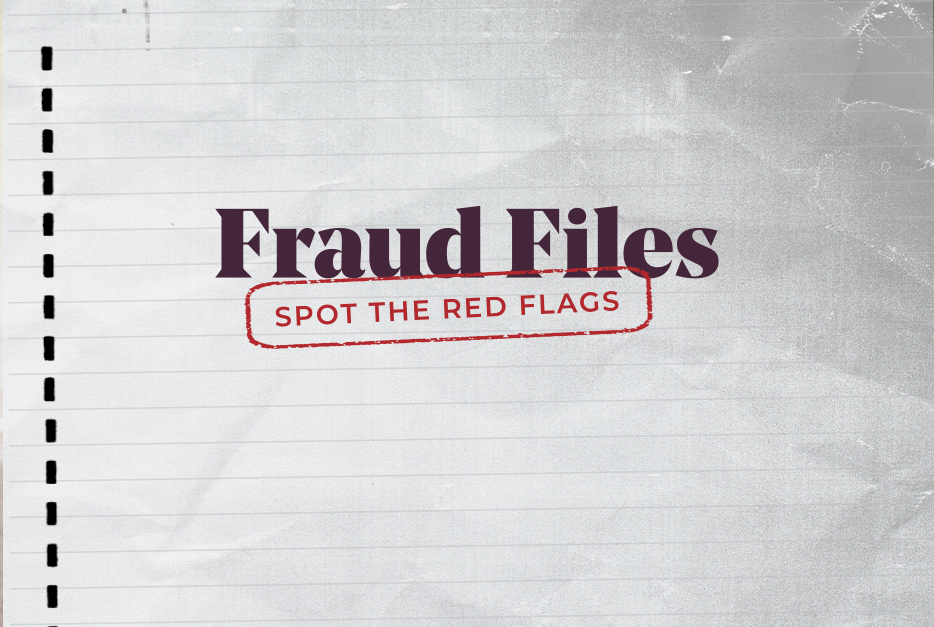Fraud Files: The opportunity of a lifetime
It’s one thing to hear about common scams — it’s another to recognize it when it happens to you. To help you spot the warning signs of fraud, we share real-life stories of the types of scams we encounter every day. To protect the identities of those involved, names and details of this story have been changed. As you read the story, try to identify what type of fraud occurred and catch the red flags of the scam.
What happened
“Once in a lifetime opportunity” — we’ve all heard the term. But what does it mean? And how do we recognize it when it comes along?
That’s the question Mark asked himself when he received an email from a financial advisor named Sebastian. Sebastian explained that he was from a prestigious investment company specializing in cryptocurrency. He told Mark that his investment firm was expanding, and they had openings for a few new clients. Spots filled fast, Sebastian said, and it could be years before this opportunity presented itself again. Was Mark interested in exploring this rapidly-growing and innovative industry?
Mark was skeptical at first. He knew a bit about cryptocurrency, and was interested in growing his investments, but he hadn’t heard of Sebastian’s firm before. Yet for every objection he raised, Sebastian had an answer. He sent Mark a link to a professional website and presentation deck. He explained how the process would work, and when Mark could expect to see returns. He even connected Mark with another client who told him about the incredible profits she had received.
Finally, Mark was ready to make an investment — but only a small one. Sebastian instructed him to visit the nearest Bitcoin ATM and send the funds using an account number Sebastian provided. Sure enough, Mark was soon receiving statements about his portfolio progress. The results were beyond what Sebastian had promised, and Mark decided to use money from his retirement fund to invest much more heavily into crypto.
After a few more months of this high performance, Mark reached out to Sebastian to withdraw some of the funds to help pay for his daughter’s wedding. Sebastian tried to dissuade him. He told Mark that it was a critical time in the market, and it wouldn’t be wise to take out any money. Mark kept pushing back, until eventually, Sebastian stopped responding.
Finally, when Mark did receive a call, it wasn’t from Sebastian — it was from a foreign law enforcement agency. They told Mark they had been investigating Sebastian’s investment firm, and suspected Mark had been a victim of a cryptocurrency scam. They assured Mark that they would be able to recover his investment — but to get around some bureaucratic red tape, they would need additional money to do so.
At this point, out over $15,000 in fake investments, Mark was desperate. His daughter was counting on him, and he was too ashamed to tell his family what had happened. So, he moved some money around in his accounts, and returned to the Bitcoin ATM, waiting for the call to say that the officials had recovered his money.
The scam
When Mark did receive a call. It wasn’t from law enforcement — it was a compliance officer from SCU. The compliance officer had noticed the series of large cash withdrawals, and was reaching out to investigate.
After Mark explained the situation, the compliance officer told Mark she suspected Mark would never get his money back. Every document sent, and every person involved — Sebastian, the other client, the foreign law enforcement officer — was likely a fraud. Mark had been scammed by an organized crime group, a network of people who work together to pull off sophisticated scams. Here’s what happens:
1. The scammer makes the pitch: Scammers will reach out through a variety of platforms — email, social media, job ads, even dating websites — trying to convince people to take advantage of this “opportunity of a lifetime.” These scammers have extensive resources to make their claims seem legitimate.
Red flag: You’ve received unsolicited contact from a person with an organization you don’t recognize. A simple way to test the legitimacy of the organization is to search “(Organization name) scams” and see if you get any results.
2. The victim deposits the funds: The scammer will request the victim send the funds through an Interac e-Transfer®, Bitcoin ATM, or even by mailing cash. Once the money is deposited, they’ll move the money quickly so funds are untraceable.
Red flag: The person creates a sense of urgency with their request, and encourages you not to talk to others about your decision. The more isolated a scammer can keep you, the fewer checks and balances you’ll have.
3. The scammer encourages the victim to give more money: Scammers will put an increasing amount of pressure to get the victim to keep “investing.” They’ll often provide fake account statements to make it seem like the victim has a real portfolio with them.
Red flag: The organization continues to pressure you for more money.
4. Once the victim gets suspicious, the scammer disappears, or a new scammer gets in touch: If a victim asks too many questions, or requests to withdraw some of the money earned, the scammers will either drop off contact altogether, or another scammer from the same crime organization will play another role.
Red flag: Once you start asking questions, the person is suddenly unreachable, or you are contacted by another person you don’t know.
What happens at SCU
Because of the lack of understanding around cryptocurrency, scams like these are very common. According to the Government of Canada, investment scams caused the highest dollar losses in 2021, with $163 million in reported losses to the Canadian Anti-Fraud Centre (CAFC).1
In this case, we were not able to help Mark recover his investment, as money deposited through a Bitcoin ATM is very difficult, if not impossible, to recover. Even so, the SCU compliance officer recommended Mark report the incident to the local authorities and the CAFC.
Key takeaway: Be skeptical of anyone promising a “once in a lifetime opportunity.” Take time to slow down, do your research, and consult with someone you trust.
Sometimes, we can help spot and stop a fraud scam before a member loses money. Unfortunately, this is not always the case. Preventing fraud is an important responsibility we all share. SCU strongly recommends that members remain vigilant and learn to protect themselves from falling victim to fraud. Visit our Fraud Prevention Centre to learn more about fraud and how to spot it, and if in doubt, reach out to SCU for help at 1.800.728.6440.
Does this story sound familiar?
If this has happened to you, or someone you know, here’s how you can report it: How to report fraud



